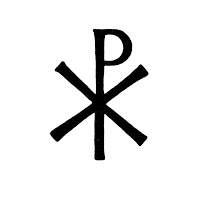As we've mentioned before on this site, each month of the year is traditionally dedicated to a specific devotion. January is dedicated to the Holy Name of Jesus.
It's easy to see how early Christians came to attach a great spiritual value on the very name of our Lord. In his letter to the Philippians, after all, St. Paul writes: "...God greatly exalted him and bestowed on him the name which is above every name, that at the name of Jesus, every knee should bend ... and every tongue confess that Jesus Christ is Lord" (Phil 2:9-11).
Names are important. They are not simply labels for a person; they are a verbal image of the person. Jesus' name, especially, is sacred. Sacred Scripture is full of examples of how the name of our Lord is powerful and effective. It is more than appropriate to honor and revere his name, for it is holy.
It is long-standing custom to bow one's head whenever the name of Jesus is uttered. In fact, Catholics are specifically instructed to bow our heads at every mention of Jesus' name during the Mass (as well as at the names of the Holy Trinity, Our Lady and the Saint being celebrated in that particular Mass).
The General Instructions of the Roman Missal (GIRM) (which you can read online here) clearly states:
"A bow signifies reverence and honor shown to the persons themselves or to the signs that represent them. There are two kinds of bow: a bow of the head and a bow of the body.
a) A bow of the head is made when the three Divine Persons are named together and at the names of Jesus, of the Blessed Virgin Mary, and of the Saint in whose honor Mass is being celebrated." (GIRM, No. 275)
 |
| St. Bernadine of Siena (d. 1444) |
Today, it is common to see the monogram that Sts. Bernadine and John of Capistrano promoted used in Church artwork or as a decorative motif in churches and on sacred vestments. This monogram is comprised of three letters: IHS. These correspond to a Latinization of the first three letters in the Greek version of Jesus' name: IHSOYS (sometimes, it is written IHC, because C and S are interchangeable). So, this monogram is basically an abbreviation of Jesus' name.
There are other monograms associated with our Lord as well. Another well-known example is sometimes called the Christogram - a symbol where the Greek letters Chi (X) and Rho (P) are interposed on one another. This symbol is known as the "Chi Rho" (real original, huh?), and it is an ancient abbreviation for the Greek title "Christos,"or Christ. Chi and Rho are the first two letters in the spelling of this word. The Chi Rho has been used by Christians since the early centuries of the Church and it was adopted by the Roman Emperor Constantine as a symbol of his Christian faith and a symbol of the Empire. He had his soldiers paint the Chi Rho on their shields before battle and used it on the coinage that he minted, as did other Roman Emperors during the fourth through seventh centuries.
My challenge to you today is to take on a brand new New Year's resolution: honor the name of Jesus. How can you do this? Well, here are three easy tips:
1) During Mass, bow your head each time Jesus' name is uttered. Yep - every time. As we pointed out above, this isn't just a pious custom, it is actually one of the instructions for the faithful during Mass. So, not only will you actually be following what the Church asks us to do, you will actually start to develop a sensitivity to the gravity and power of our Lord's holy name.
2) If you use the Lord's name in vain, stop. Whether it's used nonchalantly or even as a curse word, we are not to use the Lord's name in vain. Be deliberate with your use of the Holy Name. If you're in a bad habit of blaspheming by cussing with Jesus' name, ask for God's help to stop.
3) Work on coming to an internal reverence for Jesus' name - whenever and wherever it is spoken. Jesus name literally means "God saves." Think about that for a moment. God saves. Whenever we say the name of our Lord with reverence and begin to consciously honor his name, we reaffirm the divine truth that in Jesus, God saves. That's pretty powerful stuff. There was a time when Catholic men would remove their hats and all Catholics would bow there heads whenever Jesus' name was spoken - anywhere and everywhere. When his name was taken in vain, Catholics in the room would cross themselves and mutter a silent prayer ("Blessed be the name of the Lord!"). Pious actions such as these can influence our faith over time - and can influence the faith of others who witness them.
Finally, in honor of the Holy Name of Jesus, try praying the Litany of the Holy Name today.
So, what's in a name (or a symbol)? Power. Blessing. Truth.
Blessed be the name of the Lord! Now and forever!


